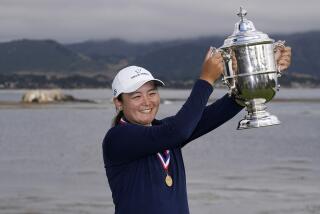Capriati Proves It’s Never Too Late to Become No. 1
- Share via
“I’d like, when I retire, when I go down the street, people would say, ‘There’s Jennifer Capriati, the greatest player who ever lived.”’
--Capriati to The Times in 1990
Of course, greatest is on another level, the one occupied by Martina Navratilova and Steffi Graf, and an arguable topic for another day. But Monday, Capriati wrapped her arms around some greatness because, at least for a week, she is officially the best in her profession.
The weekly WTA Tour rankings came out Monday and Capriati has moved past Martina Hingis, ending Hingis’ hold on No. 1. Hingis, who had been ranked first for 209 weeks--73 in succession--had ankle surgery Sunday and will miss the rest of the season. She has not won a Grand Slam title since early 1999 and the No. 1 spot was her security blanket. Frankly, though, it was thin and didn’t offer much protection at the Slams.
But this is about Capriati, not Hingis. Tennis is famous for comebacks, revivals and reinvention. You don’t have to look beyond the Andre Agassi-Steffi Graf household. Agassi dropped out of the top 100, hit the challenger circuit and returned to win four Grand Slam titles on the rebound. Graf was sidelined for months because of knee surgery and came back to win the 1999 French Open.
Still, the Capriati story is in its own category. Unlike Graf or Agassi, she never reached the top before the hard fall. A hyped prospect at 14, a fallen phenomenon a couple of years later, she left the sport and wandered through the wilderness years of teen rebellion.
Her long journey from No. 267 on April 6, 1998 to No. 1 today stands alone.
“To me, it’s a little bit more profound because I just know inside what I’ve really gone through and what it’s taken to get to this point,” Capriati said from Zurich, Switzerland, where she’s playing in the Swisscom Challenge. “I feel like I’ve almost been to hell and back.”
The 25-year-old Capriati is one of nine players to have held the No. 1 ranking since the computer system was introduced in 1975. She is the oldest to reach the top spot for the first time. For instance, Tracy Austin was 17 when she reached No. 1 for the first time in 1980, Graf was 18 in 1987 and Chris Evert was 20 in 1975.
“For some reason, whatever reason, it wasn’t supposed to happen back then,” she said of her early years on the tour. “It’s definitely been a unique journey for me, unique story for everyone. It’s definitely turned out as expected. But it doesn’t matter what age you do it, whether you’re a teenager, old, whatever.
“I’m just thrilled that I could get to this point now. And it’s never too late.... Maybe that’s why things happened the way [they] did, to make me appreciate it, understand, and [have] the perspective.”
The giddy teen who was supposed to be the next Evert just took a little longer to mature. Capriati realized she was running out of time and made a serious commitment to the sport, hiring Harold Solomon in 1999, and the results were impressive. She won at Strasbourg, France, that May, her first title in more than six years.
She kept improving, reaching the semifinals of the Australian Open in 2000, and rejoined the top 20. She won her first Grand Slam tournament this year at the Australian Open, beating No. 4 Monica Seles, No. 2 Lindsay Davenport and No. 1 Hingis in the last three rounds.
In Paris, it came full circle. Capriati won the French Open in June, beating Kim Clijsters of Belgium in an epic final, winning, 12-10, in the third set. Fittingly, that was where she’d made her Grand Slam debut in 1990, becoming the youngest semifinalist at age 14.
It took about a decade longer than expected to write the storybook ending, but how many people get the chance to get the final edit and get it right?
“I don’t need to celebrate,” she said. “The celebration is inside. I’m with my dad. We don’t even have to talk about it. It’s just knowing.”
More to Read
Go beyond the scoreboard
Get the latest on L.A.'s teams in the daily Sports Report newsletter.
You may occasionally receive promotional content from the Los Angeles Times.











